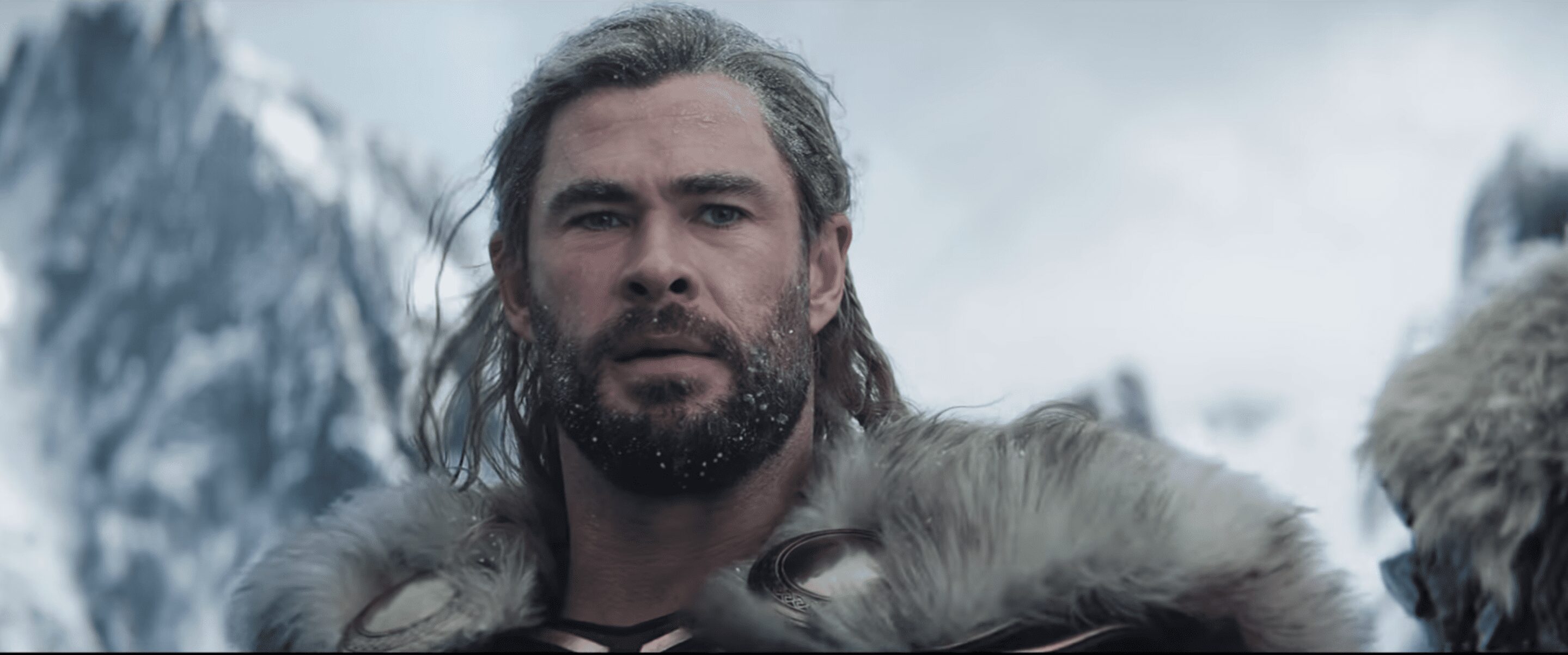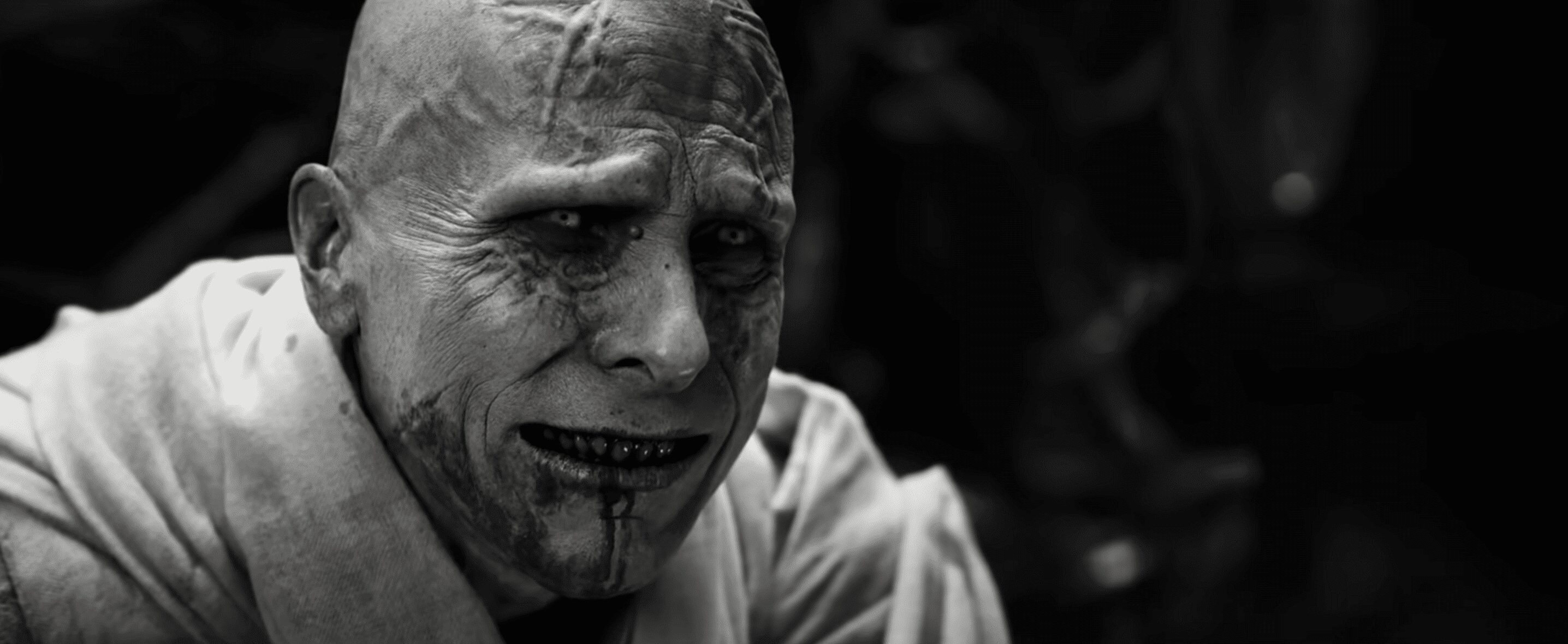Spoilers ahead for this review of Thor: Love and Thunder. Let’s start with our villain – Christian Bale’s unnervingly sinister performance as Gorr the God Butcher. Judging by that title, the name conjures horrible images of devastation and unrivalled Thanos-like power. His haggard, crude appearance is the hybrid form of Aphex Twin’s Thin Man and Lord Voldemort, from his piercing orange eyes and freakishly white skin. As for his backstory, it is surprisingly heartfelt and brimming with tragedy.
Mourning the death of his daughter, Love, (real name), the God Butcher is left vengeful against the gods for their dispassionate concern for their disciples. The Necrosword, a weapon with the power to kill gods, calls to him. Despite the sword’s curse that’ll eventually kill him, Gorr vows to kill all gods by using Stormbreaker to open the Bifrost and find Eternity, a cosmic being who’ll grant him the wish to wipe out the gods all at once. Gorr attacks New Asgard and the town’s children are abducted by shadow monsters summoned from the Necrosword.
To take on Gorr, Thor takes Jane and Valkyrie to Omnipotence City, where they meet Zeus (Russell Crowe). Zeus is cowardly and under the impression that they can remain safe from Gorr inside the city. Thor is forced to re-evaluate Zeus, the man with the thunderbolt, a god he idolises as a hero. In reality, Zeus protects his own and refuses to help in the fight against Gorr. Zeus orders the capture of Thor to prevent them from exposing Zeus’ location to Gorr. Thor kills Zeus with his thunderbolt, and they escape to the Shadow Realm.

The children cannot be located, and Gorr overpowers the group – injuring Valkyrie and stealing Stormbreaker as they return to Earth through the Bifrost. In the film’s final act – a CGI-heavy fight ensues between Thor, the abducted children imbued with the power of Zeus’ thunderbolt, and Jane within the Eternity Realm. Thor and Jane destroy the Necrosword and free Gorr from its power. After finding Eternity, the cosmic being, Bale’s villain decides to spare the gods and makes his wish – bringing his daughter back to life. Before he dies, he asks Thor to care for Love. It’s crucial, at this stage, to shine some light on the film’s other big storyline. Natalie Portman’s return to the MCU as Jane Foster, and she’s taken the mantle of Lady Thor – otherwise known as Mighty Thor.
With a reconstructed Mjolnir, Jane undergoes treatment for inoperable Stage IV cancer. Absent from the series since Thor: The Dark World, Jane’s evolution into Lady Thor makes her a worthy partner to Hemsworth’s Asgardian God. Believing the hammer can bestow Jane with healing powers, the film later reveals the power of the hammer is depleting her energy – and eventually, will kill her. This brings us back to the Eternity Realm – as Jane dies in Thor’s arms and meets Heimdall in Valhalla, a mythological afterlife for fallen Norse gods. A statue of Lady Thor is built in New Asgard to commemorate her heroism. Thor takes Love under his wing and the two charge into a battle together – nicknamed Love and Thunder.
Visually, Thor: Love and Thunder is a gorgeous cinematic experience, from the space dolphins sequence to the Shadow Realm set pieces shot entirely in black and white. The visuals are best experienced in the cinema. The film is overly reliant on comedic elements to carry the story forward, more so than the previous films. Most notably, the screaming goats wailing every second they appear on the screen and plowing into a moon in the Shadow Realm, and there’s an ice cream shop named after the Infinity Stones (Infinity Cones).

The film further attempts to romanticise Thor’s relationships with Mjölnir and Stormbreaker, as if they’ve become living things with feelings. At one stage, Thor pours a beer over Stormbreaker and gives his beloved hammer its first drink. At times, the comedic elements feel forced and out of place. Korg frequently gets Jane’s name wrong, calling her Jane Fonda and Jodie Foster – and before the film wraps, makes a rock baby with Duane – a bizarre part of his species’ mating ritual. Appearances from the Guardians are short and swift, while Matt Damon, Sam Neill, and Luke Hemsworth return as the Asgardian actors first introduced in Thor: Ragnarok. Melissa McCarthy joins the actors in a reenactment of Hela seizing Asgard (she’s playing Hela).
Darcy Lewis (Kat Dennings), who last appeared in Wandavision on Disney Plus, and Erik Selvig (Stellan Skarsgård) return to the franchise for the first time since Thor: The Dark World. Sadly, their appearances are limited to minor cameos – but it’s good to see them back. Plus, last but by no means least, we’ve got Sif (Jaimie Alexander). Once again, sadly, she only sticks around for a fleeting cameo and can be seen training the children of Asgard how to fight. It’s a great shame that such an iconic character is absent from the MCU since another fleeting cameo in Loki.
Before this, Lady Sif appeared in Thor: The Dark World and two episodes of Marvel’s Agents of SHIELD. Naturally, the film also bestows us with a handful of sneaky Easter Eggs to watch. There’s a stone statue of Arishem in the Eternity Realm, the Celestial Host from last year’s Eternals, including the stone head of The Watcher from What If?…

In conclusion, Thor: Love and Thunder is a solid entry into the fourth phase of the MCU. Jane Foster is worthy of the Lady Thor mantle as the film acknowledges her official title during the last fight with Gorr. Following the mildly disappointing Thor: The Dark World – Jane’s evolution is a vast improvement. Thor: Love and Thunder is not the best MCU film to come out of Phase 4 – that title still goes to Spider-Man: No Way Home. However, like its predecessor, Thor: Ragnarok, Taika Waititi’s second directorial in the MCU is wild, bright, and eccentric. Waititi injects his flair of zany into the movie, and it’s all the better for it.
The tone, however, is a tad inconsistent – switching from super dark scenes dripping with menace and threat to scenes packed with daft humour and Zeus whipping off Thor’s clothes, leaving it tonally disjointed. The true downfall of an otherwise entertaining, funny, visually stunning film comes from wasted opportunities. Sadly, the film has no sign of Loki. No cameo and only a small handful of references to Tom Hiddleston’s character. Thor is unaware of Loki’s resurrection and his work with the TVA, and the film shows no signs of connecting to Loki’s multiversal shenanigans. The Guardians are absent after the first twenty minutes, and Lady Sif is reduced to a bit-part cameo.
For more Marvel content, including the recent news that Captain America 4 has found a director, make sure to look at FlickLuster’s review for Doctor Strange in the Multiverse of Madness.

